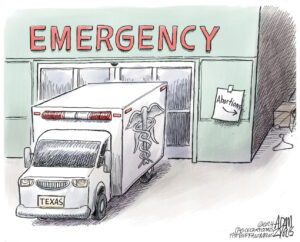This Bill Is Pro-Life Enough Already
There are any number of good reasons for House Democrats to vote against health care reform. Abortion isn't one of them.There are any number of good reasons for House Democrats to vote against health care reform. Abortion isn’t one of them.
At least, it shouldn’t be. There is scant difference between the House bill that anti-abortion advocates deem acceptable and the Senate version they claim would allow federal funds to underwrite abortions.
If anything, both versions would end up restricting abortion coverage more than under current law. Some women whose insurance covers abortion would lose that benefit as their policies move to the new insurance exchanges.
If anything, health care reform would have the impact of reducing the number of abortions. More women will have coverage that includes contraception. Pregnant women would know that their medical care, and that of their child, will be covered.
If anything, government funds are already used to pay for abortion on a massive scale. Employer-sponsored insurance policies, most of which include abortion coverage, benefit from a fat government subsidy: they are provided tax-free.
Compare the language of the Senate and House measures and try to find the supposed differences. Both measures would prevent insurers from being required to cover abortions. Both measures would continue the existing prohibition on federal funds being used to pay for abortions.
So, for example, as Medicaid is expanded to cover more low-income people, federal money will not be used to pay for abortions for Medicaid recipients. (States would remain free to use their own money to cover abortions under Medicaid — which undermines the argument that money is fungible and it is not possible to adequately segregate federal funds.)
In addition, as Washington and Lee law professor Timothy Jost points out in his useful analysis of the two measures, the Senate bill is stronger in some ways than the House measure in preventing abortions. It would explicitly allow states to bar insurers participating in the exchanges from offering abortion coverage. It includes $250 million in funding for pregnant teens and teenage mothers. It expands the adoption tax credit and adoption assistance programs.
One relatively new argument against the Senate bill is that the ban on government funding of abortion does not explicitly include community health centers, which would receive billions more in funding. Except: These centers already receive federal funds. They don’t perform abortions. And existing regulations prohibit them from performing abortions with federal funds. If the absence of an explicit legislative ban is a problem, why wasn’t it raised when, for example, the stimulus bill appropriated another $2 billion for community health centers?
So the real dispute boils down to how the two bills treat abortion coverage provided on the insurance exchanges. The House bill, through the amendment written by Rep. Bart Stupak, D-Mich., explicitly prohibits federal insurance subsidies from being used for abortions, except in cases of rape, incest or to save the life of the mother. The Senate bill, with the compromise crafted by Sen. Ben Nelson, D-Neb., accomplishes the same result by reference to the Hyde Amendment — which has been included in every health appropriations bill since 1976 and is in no danger of being dropped. The practical difference is nil.
Then there is the question of how insurers participating in the exchanges could offer abortion coverage. The House bill requires those who want to obtain abortion coverage to buy a separate policy, using no federal funds. The Senate bill requires that plans covering abortions collect a separate premium check for this coverage. Separate policy versus separate premium: This is enough of a difference to affect the fate of the legislation? Hardly — and the hurdles to offering separate abortion coverage are high enough that few if any insurers are likely to do so.
You might ask: If there’s no real difference between the two, why don’t Democrats simply accept the House language? They can’t, at this point. The House has to pass the Senate bill as is. Some changes can be made under the rules of reconciliation, but not on the abortion language.
The Catholic Health Association, which represents Catholic hospitals, supports the Senate bill. But Catholic bishops are strongly opposed, and anti-abortion lawmakers who vote for reform will be marked down by the National Right to Life Committee. As Douglas Johnson, the group’s legislative director, told The Associated Press, “No Catholic hospital executive has ever turned out hundreds of volunteers to man the phone banks or walk the precincts for an endangered congressman or his challenger.”
On this one, sadly, facts may matter less than muscle.
Ruth Marcus’ e-mail address is marcusr(at symbol)washpost.com.
© 2010, Washington Post Writers Group
Your support matters…Independent journalism is under threat and overshadowed by heavily funded mainstream media.
You can help level the playing field. Become a member.
Your tax-deductible contribution keeps us digging beneath the headlines to give you thought-provoking, investigative reporting and analysis that unearths what's really happening- without compromise.
Give today to support our courageous, independent journalists.






You need to be a supporter to comment.
There are currently no responses to this article.
Be the first to respond.